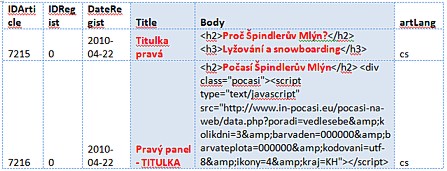More and more clients use the Content Management Systems for their websites and publishing information. Some of these CMS systems allow for translations, but the work mostly needs to be done on-line and we, translators, can forget about using the CAT tools, which can save us much time and effort (and allow us to make more money in shorter time). This article describes how to prepare a file exported from CMS in the Microsoft Excel format for translation in Trados.
Fortunately, all CMS (should) allow exporting the data into translation-friendly format, such as Microsoft Excel files. The bad point is that these files contain a lot of HTML formatting (tags), which are not recognized by CAT (in my case Trados – I will use this from now on). Without special preparation, the tags will be included in the source as a normal text rather than tags. Not all translators are familiar with HTML, so this may result in damaging the HTML code, removing parts of the code, and all other kinds of problems. Translation memory created using “unprepared” text will be useless, since it would contain all HTML codes and will not produce any leverage for any further translation projects.
Let’s take a look at the sample of XLS export.
We want to translate only the red & bold text and leave all other text as it is. Thus, we have to prepare the data for translation in Trados.
First, keep a copy of the original file, since we will be deleting some data from the XLS and later we will be copying translated text back into the XLS.
- Open the XLS, you will use for preparing the data for translation.
- We certainly do not need to translate the header line, so delete it. You may also delete any other text that you do not wish to translate, but do not forget that you will have to copy such text back into XLS after translation.
- Save the XLS as a tab-delimited text file.
- Start Microsoft Word and open the TXT file you have just created.
- Now we want to convert all HTML tags into non-translatable text. All HTML tags start with “<” and end with “>”. We will use this feature.
- In Microsoft Word, open the “Find and Replace” dialog box (CTRL+H) and click the “Replace“ tab. Press “More” button. Select the “Use Wildcards” check box. Enter “\<*\>” into the search keyword field. Click the “Replace With” field, but leave it empty. Click the “Format” button, select “Style“, and select the “tw4winExternal” style.
- Click “Replace All“. This will format all non-translatable text as “external tags”.
- Save the DOC. This is now our source file, which we will translate in Trados.
We need to adjust some settings of the translation memory in Trados Translator’s Workbench.
- Start Translator’s Workbench.
- Click “File” -> “Setup“.
- Click “Non-translatable Text” tab.
- Click “Open File“, select the DOC you have prepared for translation, and click “Open“.
- A list of available styles will be shown in the right box. Select all styles beginning with “tw4win” and press the “<<Copy” button. Select the “External” radio button. Click OK.
- Start Trados TagEditor.
- Open the DOC for translation and translate the file.
- When you are finished with translation, save the bilingual file into DOC (“File” -> “Save Target As“).
Now you have a translated DOC file, which you need to convert back into the original XLS file.
- Start Microsoft Word and open the translated DOC.
- Save the file as a plain text (Plain TXT). I recommend choosing “Other Encoding” option and selecting the “Unicode (UTF-8)” option to make sure you do not get distorted characters. Click OK.
- Close DOC and Microsoft Word.
- Start Microsoft Excel. Open the TXT you have created in step 2 (“File” -> “Open“, select “All Files” in the drop-down box next to “File Name” field).
- In the Import Wizard, select “Separator” radio button and click “Next” button.
- In Separators area, select “Tab” check box only. Select “None” as the “Text Qualifier“. Click “Next“.
- Click “Finish“. Save the file into XLS format.
We now have a translated XLS file. The last thing to do is to replace the data in the original XLS with translation.
- Open the original XLS.
- Open translated XLS and copy the translated data.
- Paste translated data into the original XLS replacing the source data.
- Save the file and you are done.
Note: The process as described above may be too lengthy for short files. Personally, I would perform this conversion and translation in CAT only for websites with word count exceeding 2,000 words with some reasonable fuzzy leverage.


